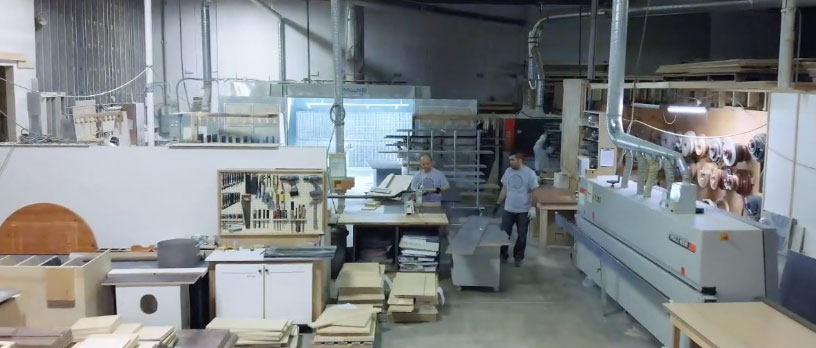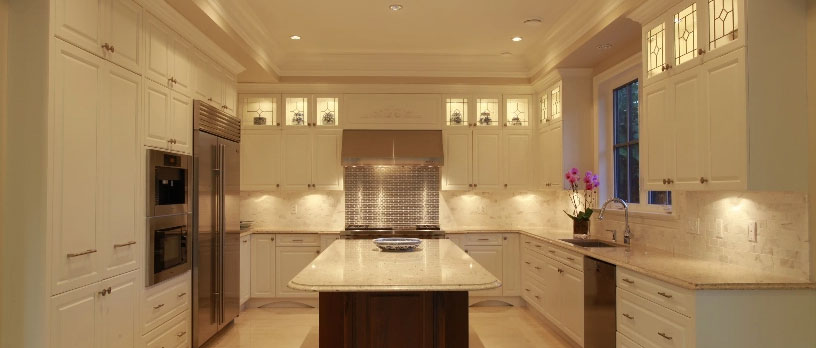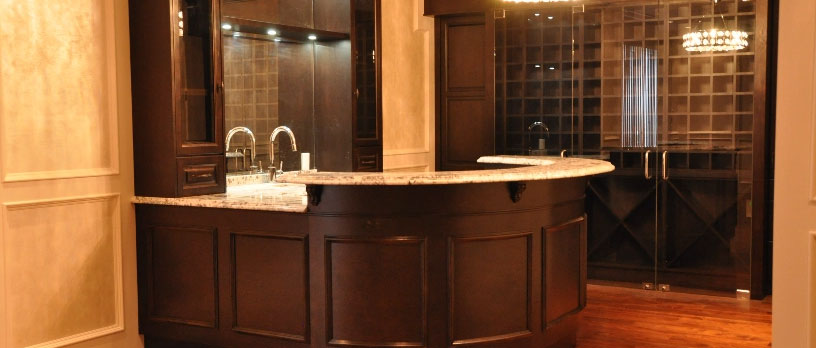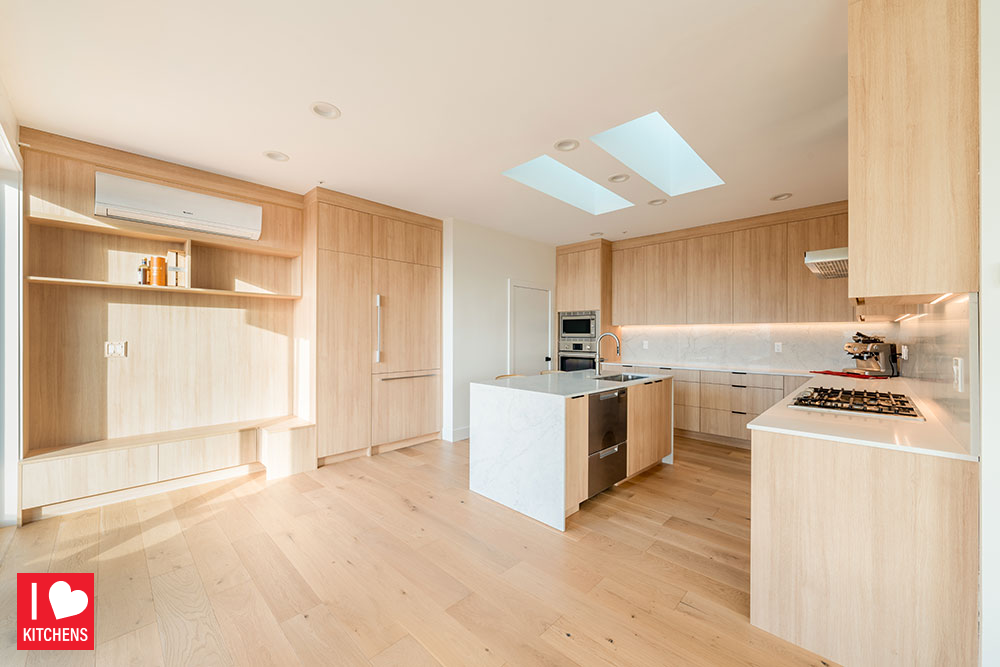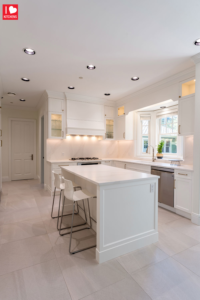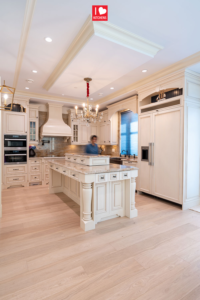When planning or redesigning a kitchen, one of the most critical aspects that often gets overlooked is lighting. Lighting is not just a functional necessity—it is a design element that affects how your kitchen looks, feels, and operates. Good lighting can enhance the beauty of your kitchen, improve functionality, and set the right mood for various activities. Whether you’re renovating your kitchen or designing a new one, getting the lighting right is essential. In this comprehensive guide, we will explore the importance of lighting in kitchen design and provide expert advice on how to achieve the perfect lighting setup.
Understanding the Role of Lighting in Kitchen Design
Lighting plays a multifaceted role in kitchen design. It impacts both the aesthetics and functionality of your space, and without proper lighting, even the most beautiful kitchen can feel incomplete. In kitchen design, lighting serves to:
- Enhance visibility: Proper lighting ensures that work areas, such as countertops, sinks, and stovetops, are well-lit for tasks like cooking and cleaning.
- Create ambiance: Lighting helps set the mood, whether you’re hosting a dinner party, enjoying a quiet breakfast, or prepping for a busy day.
- Highlight design elements: Strategic lighting draws attention to design features like countertops, backsplashes, and custom cabinetry.
- Improve safety: Adequate lighting helps prevent accidents by ensuring that you can see what you’re doing, especially when working with sharp tools or hot surfaces.
Types of Lighting in Kitchen Design: A Comprehensive Overview
To achieve the perfect balance of aesthetics and functionality, it’s essential to understand the different types of lighting used in kitchen design. These include ambient, task, accent, and natural lighting. Each serves a specific purpose, and the key to a well-lit kitchen is layering these types effectively.
Ambient Lighting: Setting the Base for Your Kitchen Design
Ambient lighting, also known as general lighting, provides overall illumination for the entire kitchen. It sets the tone for the room, ensuring that there is enough light for basic tasks and navigation. Recessed lighting, ceiling-mounted fixtures, or chandeliers are common sources of ambient light. However, relying solely on ambient lighting can leave work areas in shadow, which is why it’s important to incorporate other lighting types as well.
Task Lighting: Enhancing Functionality in Kitchen Design
Task lighting focuses on illuminating specific work areas, such as countertops, sinks, and cooking spaces, where precision and clarity are needed. Without adequate task lighting, food preparation and cooking can become difficult and even dangerous. Here are some of the most effective task lighting solutions for your kitchen:
Under-Cabinet Task Lighting for Enhanced Efficiency
Under-cabinet lighting is a popular choice for task lighting because it illuminates countertops without casting shadows. These lights are installed beneath the upper cabinets and provide direct light to work surfaces, making it easier to chop vegetables, read recipes, and perform other detailed tasks.
Pendant Task Lighting for Workspaces
Pendant task lighting is both functional and aesthetically appealing, making it ideal for illuminating kitchen islands or countertops. These hanging fixtures provide focused, direct light, perfect for detailed tasks like chopping or reading recipes. Pendants come in various styles, materials, and sizes, allowing you to enhance your kitchen’s design while adding practical lighting. By suspending the pendants at the right height, you ensure optimal lighting coverage, creating a well-lit, stylish workspace in your kitchen.
Accent Lighting: Adding a Stylish Touch to Kitchen Design
Accent lighting is used to highlight specific features of your kitchen design, such as architectural details, artwork, or decor. It can create a sense of depth and add visual interest to the space. While accent lighting isn’t essential for functionality, it contributes to the overall aesthetic of the room.
LED Strip Lights for Accentuating Custom Kitchen Features
LED strip lights are a versatile and energy-efficient way to accentuate custom kitchen features, such as countertops, shelving, or cabinetry. These flexible light strips can be installed under cabinets or along the edges of countertops, adding a modern, sophisticated touch to the space. They highlight architectural details, create depth, and add ambient lighting, enhancing both form and function. LED strips come in various color options, allowing for customization that aligns with your kitchen’s style.
Display Lighting for Highlighting Custom Kitchen Renovation Details
Display lighting is essential for showcasing the unique features of your custom kitchen renovation. Whether it’s highlighting glass-front cabinets, a wine display, or decorative items, these lights enhance the visual appeal of key design elements. Recessed lights, LED strips, or small spotlights are commonly used to create focus without overwhelming the overall design. Display lighting helps draw attention to personalized details, making them stand out while contributing to the overall atmosphere of the kitchen.
Natural Lighting: A Key Element in Effective Kitchen Lighting Design
Natural lighting plays a significant role in kitchen design by brightening the space, enhancing color schemes, and creating a welcoming atmosphere. Large windows, skylights, or glass doors allow sunlight to flood the room, reducing the need for artificial light during the day. Natural light also improves visibility and highlights architectural details. A well-lit kitchen with ample natural light feels more open, making it a key factor in both the aesthetics and functionality of the space.
Maximizing Daylight in a Custom Kitchen Renovation
When planning a custom kitchen renovation, think about how you can maximize the amount of daylight that enters the space. Large windows, skylights, and glass doors are excellent ways to flood your kitchen with natural light. Daylight not only brightens the room but also highlights design details in a way that artificial light cannot.
Window Placement to Optimize Natural Light in Kitchen Design
Strategic window placement is critical for optimizing natural light in kitchen design. By positioning windows to capture maximum sunlight throughout the day—such as east-facing for morning light or south-facing for consistent brightness—you can flood your kitchen with natural illumination. Placing windows above sinks or near cooking areas ensures task zones are well-lit. Skylights or transom windows are also effective for maximizing natural light, creating an airy and energy-efficient kitchen environment.
Layered Lighting in Kitchen Design: The Ultimate Guide
One of the most important principles in kitchen lighting design is the use of layers. Layering involves combining different types of lighting—ambient, task, accent, and natural—to create a balanced and functional lighting scheme.
Balancing Ambient, Task, and Accent Lighting in Custom Kitchen Renovation
A well-balanced lighting scheme combines ambient, task, and accent lighting to create a fully functional and visually pleasing kitchen. Ambient lighting provides overall illumination, task lighting focuses on workspaces, and accent lighting highlights decorative elements. In a custom kitchen renovation, balancing these layers ensures every area is well-lit for its purpose, from food preparation to dining. The right balance enhances usability, reduces shadows, and creates an inviting atmosphere, elevating the overall kitchen design.
Lighting Placement in Kitchen Design: Achieving Optimal Results
Even the most beautiful light fixtures won’t be effective if they’re placed incorrectly. Lighting placement is key to creating a well-lit, functional kitchen. Work areas should have direct lighting to ensure that tasks can be performed safely and efficiently, while dining and social areas may require softer, more diffused lighting.
Lighting Zones: Organizing Your Kitchen for Functionality and Style
Dividing your kitchen into lighting zones allows you to address the specific needs of each area. For example, the cooking zone may need brighter, more focused lighting, while the dining area might benefit from warmer, softer light. Organizing your kitchen into zones ensures that each area is appropriately lit for its intended purpose.
Creating a Focal Point with Lighting in Kitchen Design
Lighting can be used to create a focal point in your kitchen, drawing attention to a particular area or design feature. For instance, pendant lights over a kitchen island can serve as a focal point, while under-cabinet lighting highlights the backsplash and countertops. This technique adds depth and interest to your kitchen design.
Custom Lighting in Kitchen Design: Tailoring Solutions to Your Space
Custom lighting solutions allow you to personalize your kitchen’s design and functionality. Tailored to fit your specific needs and preferences, custom lighting can highlight architectural features, provide optimal task illumination, or create a particular ambiance. Whether through unique fixtures, adjustable lighting systems, or strategic placement, custom lighting ensures that your kitchen is as functional as it is beautiful. It helps maximize efficiency and style, catering to the unique layout and usage patterns of your space.
Integrating Custom Lighting Fixtures into Kitchen Renovation Projects
Integrating custom lighting fixtures into your kitchen renovation allows you to personalize both the aesthetic and functional aspects of your kitchen. Whether you choose statement pendants, recessed lights, or under-cabinet LED strips, custom fixtures can be tailored to match your design theme and specific needs. Thoughtfully planned lighting enhances the overall ambiance and ensures that each area of your kitchen is well-lit, providing a seamless blend of style and practicality in your renovation project.
Choosing the Right Custom Lighting for Your Kitchen Style
The style of your kitchen will influence the type of lighting you choose. For a modern kitchen, minimalist fixtures with clean lines may be appropriate, while a more traditional kitchen might call for ornate chandeliers or classic pendant lights. Custom lighting fixtures can be tailored to match the overall aesthetic of your space.
Working with Professionals for Custom Kitchen Lighting Solutions
Hiring a professional lighting designer can help ensure that your custom kitchen lighting is both functional and visually appealing. Professionals can assist with selecting the right fixtures, creating a lighting plan, and ensuring that the installation is done correctly. They can also help you avoid common mistakes, such as improper placement or inadequate lighting levels.
The Impact of Color Temperature on Kitchen Lighting and Design
Color temperature refers to the warmth or coolness of a light source, and it plays a significant role in how your kitchen looks and feels. Choosing the right color temperature can enhance the overall ambiance and functionality of your kitchen.
Warm vs. Cool Lighting: Finding the Right Balance for Your Kitchen
Warm lighting (2700K-3000K) creates a cozy, inviting atmosphere, while cool lighting (4000K-5000K) is more energizing and better suited for tasks that require focus. In kitchen design, it’s important to strike a balance between warm and cool lighting. For example, warm lighting can be used in dining areas to create a relaxing environment, while cool lighting is ideal for task areas where precision is needed.
How Lighting Affects the Color Scheme of Your Kitchen Design
Lighting dramatically influences how colors appear in your kitchen design. Warm lighting tends to bring out rich, earthy tones, while cool lighting highlights crisp, clean hues. The color temperature of your lights can either enhance or dull the vibrancy of your cabinetry, countertops, and backsplash. Therefore, it’s essential to test different lighting scenarios to see how they interact with your color scheme. Proper lighting ensures your kitchen looks cohesive and visually appealing in various lighting conditions.
Energy-Efficient Lighting in Kitchen Design: What You Need to Know
Energy-efficient lighting is an essential consideration in modern kitchen design. Not only does it reduce your carbon footprint, but it also saves money on electricity bills over time.
LED Lighting Solutions for Kitchen Renovation Projects
LED lighting has become a popular choice for kitchen renovation projects due to its energy efficiency, durability, and versatility. LED fixtures come in a wide range of styles, from under-cabinet lights to recessed ceiling lights, offering flexibility for different kitchen layouts. These lights provide bright, consistent illumination while using significantly less energy than traditional bulbs. With customizable color temperatures and dimmable options, LED lighting solutions ensure a well-lit, eco-friendly, and visually appealing kitchen space.
Long-Term Savings with Energy-Efficient Kitchen Lighting
Investing in energy-efficient kitchen lighting can result in significant long-term savings. LEDs, in particular, consume far less electricity than traditional incandescent or halogen bulbs, reducing your monthly energy bills. Additionally, their long lifespan means fewer replacements, saving both time and money. Over time, energy-efficient lighting can pay for itself through reduced energy consumption and lower maintenance costs, making it a smart, eco-conscious investment for any kitchen renovation project.
Eco-Friendly Lighting Options for Custom Kitchen Designs
Eco-friendly lighting options, such as LED bulbs, CFLs, and halogen lamps, are ideal for reducing energy consumption in custom kitchen designs. These sustainable options not only lower electricity usage but also minimize environmental impact by reducing greenhouse gas emissions. Solar-powered lights and dimmer switches are other eco-conscious choices that help control energy use. By integrating environmentally friendly lighting into your custom kitchen, you contribute to a greener planet while enhancing the efficiency of your space.
Smart Lighting Solutions for Modern Kitchen Design
Smart lighting solutions offer enhanced control, convenience, and efficiency in modern kitchen design. With smart systems, you can control your kitchen lights through smartphone apps or voice-activated devices, such as Amazon Alexa or Google Home. These systems allow you to adjust brightness, set schedules, or change lighting colors remotely. Motion sensors and dimmers also add convenience and energy savings. Smart lighting brings innovation to your kitchen, improving both its functionality and ambiance.
Smart Lighting Controls: Enhancing Convenience in Your Kitchen Design
Smart lighting controls, such as dimmers, timers, and motion sensors, allow you to adjust the brightness and timing of your kitchen lighting with ease. These controls can be operated via smartphone apps or voice commands, providing ultimate convenience and flexibility in your kitchen design.
Integrating Voice-Activated Lighting Systems into Custom Kitchens
Voice-activated lighting systems, such as those compatible with Amazon Alexa or Google Home, allow you to control your kitchen lighting with simple voice commands. This hands-free technology is especially useful in the kitchen, where your hands may be occupied with cooking or cleaning.
The Importance of Lighting Placement in Custom Kitchen Renovation Projects
Proper lighting placement is crucial in kitchen design. Poorly placed lighting can create unwanted shadows or glare, while well-placed lighting enhances both the functionality and aesthetics of your kitchen.
The Role of Dimmers in Custom Kitchen Lighting
Dimmers allow you to adjust the brightness of your kitchen lighting to suit different tasks and moods. Whether you need bright lighting for food prep or soft lighting for a relaxing dinner, dimmers give you control over the intensity of your lights, making them a valuable addition to custom kitchen renovation projects.
How to Avoid Shadows and Glare in Your Kitchen Design
To avoid shadows and glare in your kitchen, it’s essential to carefully plan your lighting placement. Task lighting should be positioned so that it illuminates work areas without casting shadows, while ambient lighting should be evenly distributed throughout the space. Avoid placing lights directly above shiny surfaces, such as stainless steel appliances, to prevent glare.
Planning Your Kitchen Lighting Design: Practical Tips for Success
Planning your kitchen lighting design involves careful consideration of both aesthetics and functionality. Begin by evaluating the natural light available, then plan for layered lighting, combining ambient, task, and accent lighting to ensure all areas are adequately lit. Pay attention to fixture styles that complement your kitchen’s design. Lastly, budget for energy-efficient options like LEDs and consider smart technology for greater control. Thoughtful planning results in a well-lit, efficient, and stylish kitchen.
Budgeting for Custom Kitchen Lighting During a Renovation
When budgeting for custom kitchen lighting during a renovation, it’s important to allocate funds for both fixtures and installation. Quality lighting can be a significant investment, especially if opting for custom or designer pieces. Consider the long-term benefits of energy-efficient options like LEDs, which may cost more upfront but save on electricity bills over time. Make sure to account for dimmer switches, smart controls, and professional installation to avoid surprises later in the renovation process.
Matching Lighting Fixtures with Your Custom Kitchen Renovation Style
The style of your kitchen renovation will guide your choice of lighting fixtures. For a sleek, modern kitchen, opt for minimalist fixtures like recessed lights or contemporary pendants. Traditional kitchens might benefit from ornate chandeliers or classic sconces. Transitional designs can blend elements by incorporating both modern and traditional lighting. Matching the fixtures to your kitchen’s overall aesthetic enhances visual cohesion, ensuring that your lighting complements, rather than competes with, the space’s design features.
In conclusion, lighting is a critical aspect of any successful kitchen design. By understanding the different types of lighting, carefully planning your lighting layout, and choosing energy-efficient and custom lighting solutions, you can create a kitchen that is both functional and visually stunning. Whether you’re embarking on a custom kitchen renovation or simply updating your lighting, the right choices can transform your space. For more advice on kitchen design, or if you’re considering a kitchen renovation vancouver, explore the available resources and get in touch with experts who can help bring your vision to life.

